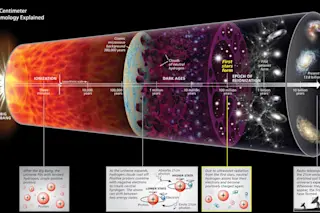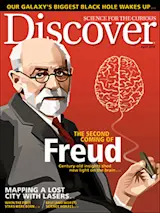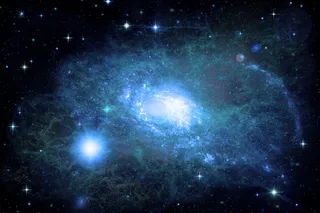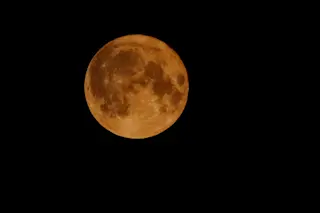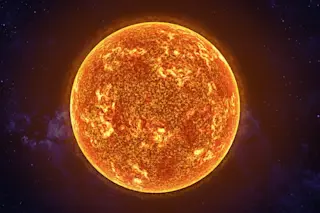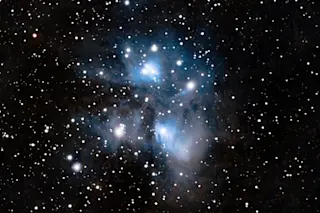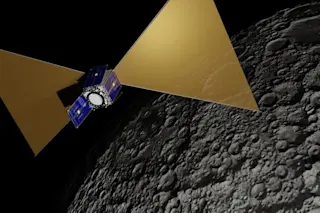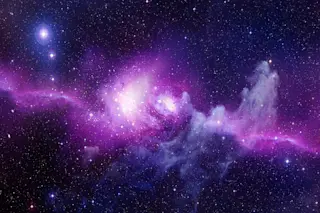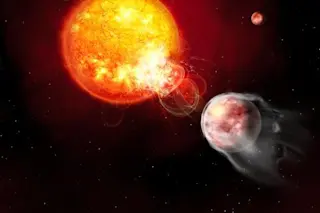A few years ago, Avi Loeb spent some time with his family near Cradle Mountain in the highlands of central Tasmania, a rugged island 150 miles south of Australia. Their cabin had no Internet connection, affording Loeb some free time after dinner to step outside and look up at the clear night sky, untainted by any trace of urban glow. He was bowled over by a dazzling spectacle: the countless stars of our galaxy, the Milky Way, airily stretched across the heavens. Off to the side, he could see our nearest galactic neighbor, Andromeda, a twinkling, iridescent patch roughly the size of the moon.
Taking in the view for hours, Loeb, chairman of Harvard’s astronomy department and director of its Institute for Theory and Computation, was overwhelmed upon seeing the things he studied as a theorist suddenly made palpable. While admiring the celestial display, he felt a heightened resolve to answer the question long at the heart of his research agenda: How and when did the first generation of stars and galaxies light up?
The Bible attributes the appearance of these luminous sources to a divine proclamation: “Let there be light.” But Loeb wanted to tell the scientific version of the Genesis story instead.
Chasing Starlight
A youthful-looking 52 with short-cropped brown hair and a compact, athletic build, Loeb did not always plan on becoming an astrophysicist. Born and raised on a farm in Israel, he spent weekends seeking out quiet spots to read and think. “I soon realized that philosophy asked the fundamental questions but often didn’t resolve them,” says Loeb. Science, he realized, might put him in a better position to provide some answers.
He got the opportunity to pursue math and physics through Talpiot, the elite eight-year military program he entered in 1980 at age 18. When he wasn’t parachuting, driving tanks or participating in naval exercises, he worked toward a Ph.D. in physics. His research — which yielded a new kind of gun for accelerating projectiles to high speeds — earned him free trips to the United States at the behest of President Ronald Reagan’s Strategic Defense Initiative (aka “Star Wars”). During these stateside visits, he toured research centers like the Institute for Advanced Study in Princeton, N.J., where the late astrophysicist John Bahcall offered him a five-year fellowship, provided that he switch from physics to astrophysics.
Loeb gladly accepted. He worked at the institute and taught himself astronomy from 1988 to 1993. “I had to learn everything from scratch,” he says. “I didn’t even know how the sun shines.” He published a number of papers, but it wasn’t until he came to Harvard in 1993 as an assistant professor that he settled on a principal theme for his work: the first sources of light. It was hardly a field at all back then, Loeb recalls, since just a handful of researchers worldwide were active in that area. He chose to focus on the birth of the earliest stars, rather than the birth of the universe some 13.8 billion years ago, because he wanted to get closer to “our cosmic roots,” as he puts it: “We are made of the heavy elements that were produced by the first stars, not by the Big Bang.”
Furthermore, while there is no foreseeable way of looking at the Big Bang directly, cosmologists can look for the first stars and galaxies with today’s telescopes and new ones being built. Loeb compares this search to archaeology, where deeper excavations uncover older artifacts. Cosmology is similar: Because light travels at a finite speed, looking at distant light sources is literally looking back in time. Therefore, spotting a galaxy that was once 13 billion light-years away (and is now much farther away because the universe is expanding) gives us a glimpse of the universe as it was 13 billion years ago.
A Star Is Born
One of Loeb’s earliest contributions to this endeavor came in the mid-1990s when he, along with graduate student Zoltan Haiman and postdoc Anne Thoul, worked out the processes that likely created the first stars. The story starts shortly after the Big Bang, which left a universe where matter was spread more or less, though not exactly, evenly: Certain regions of the cosmos started out slightly denser than average by a mere 0.001 percent. Clumpiness begot more clumpiness, as gravity pulled more matter into these dense regions, and clouds of gas, composed mostly of hydrogen atoms, began to assemble.
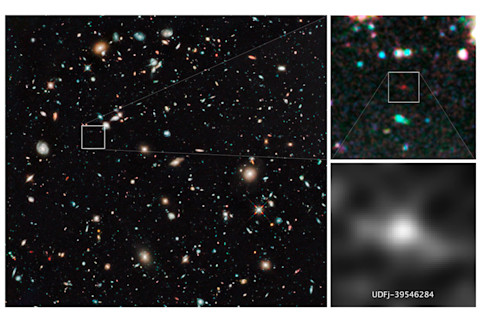
To look back in time, astronomers need only develop instruments that can see further away. In this field of galaxies, astronomers spotted one particularly distant galaxy, UDFj-39546284. Its light has been traveling toward us for 13 billion years, culminating in the view seen in the bottom righthand corner. | Deep Field: NASA; ESA; G. Illingworth, D. Magee and P. Oesch; R. Bouwens; and the HUDF09 team. Inset: NASA; ESA; G. Illingworth and R. Bouwens; and the HUDF09 team.
To simplify their calculations, Loeb and his collaborators assumed the clouds were symmetrical spheres that, under the right circumstances, could collapse to form stars. It was a delicate balancing act: Gravity tries to make the gas contract, but as the gas volume shrinks, the temperature goes up and so does the outward pressure, resisting further collapse. To make a star, the center of the gas cloud would need to become dense enough to trigger thermonuclear fusion, in which atomic nuclei fuse, releasing a burst of energy. But the cloud would never reach that critical density without some way of cooling down, thereby reducing the pressure of the gas.
Soon Loeb’s team hit upon a way that might occur. As the gas becomes denser, two hydrogen atoms could occasionally combine to form a single hydrogen molecule. These molecules initially comprise just a small fraction of the gas, but they can absorb heat from the surrounding gas and get rid of it by emitting light, thereby cooling the cloud enough for stars to form.
Loeb and his team modeled these processes as far as paper-and-pencil calculations could take them, at which point Loeb decided to enlist astronomers who had access to more sophisticated computer hardware and methodology. “Avi gave us this wonderful physics problem,” says Volker Bromm, now based at the University of Texas at Austin. “He got this whole program in computational astrophysics started by laying out the big picture.”
Over the years, the simulations of Bromm and other theorists have evolved to show that clouds following Loeb’s general pathway could give rise to multiple stars of varying sizes. In aggregate, the process could be prolific enough to give rise to the early galaxies themselves.
Prospecting for clouds
In the hopes of seeing the gas clouds from which the first stars arose, Loeb has devoted much of the past decade to a new field called 21-centimeter cosmology, a branch of radio astronomy that focuses on identifying electromagnetic radiation that started out with a wavelength of 21 centimeters. This technique exploits the fact that the clouds in question, the progenitors of stars, are composed primarily of hydrogen atoms. Each hydrogen atom, made up of just a single proton and electron, can be found in two slightly different states: a higher energy state in which the electron and proton essentially spin in the same direction, and a lower energy state in which they spin in opposite directions. When the atom drops from the higher to the lower energy state, it emits a photon, or light particle, in the form of a radio wave 21 centimeters long. By finding places in the sky where radio telescopes pick up these 21-centimeter emissions, astronomers can identify light from faraway, hydrogen-rich regions so ancient they date back to the era when stars were starting to form.
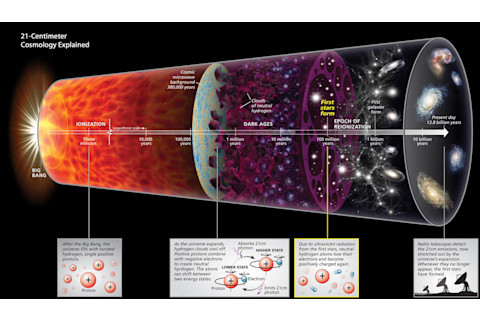
The new field of 21-centimeter cosmology is a branch of radio astronomy that focuses on identifying electromagnetic radiation that started out with a wavelength of 21 centimeters. | Roen Kelly
Loeb and his Harvard colleague at the time, Argentine-born astrophysicist Matias Zaldarriaga, caught the interest of the observational community when they explained how 21-centimeter cosmology could provide a more detailed picture of the universe than ever before. The approach offers astronomers the only way yet devised of peering into the so-called “dark ages” — the murky period between the Big Bang and the time, roughly 100 million years later, when starlight began bathing the cosmos.
Another potential payoff could be charting the evolution of the universe as a whole. Remember, the universe has continued to expand since the moment of the Big Bang and long after those dark ages came and went. Not only does space stretch, but so do light and other forms of electromagnetic radiation. Now suppose that the 21-centimeter radio waves from a hydrogen cloud were emitted when our universe was just 500 million years old. By the time those radio waves reached us, some 13 billion years later, the universe would have expanded by factor of 10. The radio waves, which started out as 21-centimeter signals, would have stretched out by the same factor of 10, registering as 210-centimeter radio signals at receivers on Earth. Radio waves that originated at a later time in cosmic history, on the other hand, might be stretched only, say, fivefold, arriving here as 105-centimeter signals. By capturing radio signals given off by gas clouds, Loeb and Zaldarriaga told their peers, they could explore the history of the universe with greater clarity than ever before.
Epoch of Reionization
With new radio antenna arrays now being deployed for this purpose, the cosmologists plan to begin their search by determining exactly when star formation began. To understand the approach they’re taking, let’s revisit the fiery aftermath of the Big Bang, when most ordinary matter consisted of hydrogen atoms.
Due to the high temperatures and intense radiation present, these atoms initially existed in an “ionized” state: The negatively charged electrons had been stripped from positively charged protons, leaving behind positive hydrogen ions (essentially, just protons). Some 380,000 years after the universe’s explosive debut, things cooled down enough for electrons and protons to combine to form so-called “neutral” hydrogen — hydrogen with its electrons in tow, thus having no net electrical charge. Hydrogen atoms remained in this neutral state until stars and galaxies began to form. In addition to emitting visible light, the stars also gave off ultraviolet (UV) radiation, which split the neutral hydrogen it encountered into electrons and protons — ionizing it once again, and thereby launching what researchers call the “epoch of reionization.”
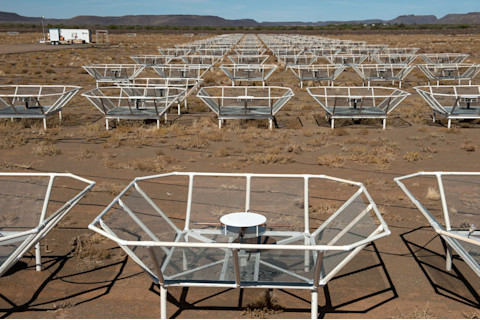
The Precision Array to Probe the Epoch of Reionization will help pinpoint the earliest stars' births. | SKA South Africa
An ionized hydrogen atom, consisting of a proton shorn of its associated electron, cannot undergo the 21-centimeter transition discussed above, since that transition depends on the relative spins of the electron-proton pair. Astronomers, therefore, look for signs of reionization by determining when 21-centimeter emissions start to turn off — evidence that stars are, simultaneously, starting to turn on. Their tactic, in other words, is to seek out the effects of the first stars rather than the stars themselves.
This predicted shutdown in 21-centimeter radio signals will not occur everywhere at once, Loeb says. To picture what happens, he suggests imagining a block of Swiss cheese. The holes in the cheese represent places around stars and galaxies where UV radiation has ionized hydrogen atoms, bringing 21-centimeter emissions to a halt. The solid parts of the cheese represent places farther removed from the radiation, where neutral hydrogen still exists.
Over time, Loeb says, the holes keep growing and eventually overlap until there is no “cheese” (neutral hydrogen) left. We know this is the case because the universe is almost completely reionized today and has been for more than 12 billion years. In fact, Loeb claims that 99.99 percent of the universe’s volume was reionized during the 950 million years that followed the Big Bang.
When, during that time, did the stars switch on? One observer inspired to find out was Aaron Parsons at the University of California, Berkeley. Parsons is co-principal investigator on the Precision Array to Probe the Epoch of Reionization (PAPER), a 128-antenna telescope in South Africa’s Karoo Desert. Parsons explains his goals this way: The first stars generated UV radiation, and at some point these stars produced enough radiation to ionize the gas lying between galaxies. “The question is, ‘When did that happen?’ ” he says. Instead of looking at the stars, Parsons is trying to catch the moment when the 21-centimeter signal disappears, which should correspond to the time when most of the hydrogen became ionized.
For starters, Parsons and his collaborators are essentially looking at many single, two-dimensional slices of “Swiss cheese” and counting the number of holes to get a statistical measure of how patchy the cheese is — the number of holes indicating how far along reionization is. If that approach proves successful, the plan is to expand PAPER or build a new and improved instrument that could directly map in three dimensions the distribution of neutral hydrogen and the “cheese holes” where neutral hydrogen is absent. That would provide a fuller picture, and chronology, of reionization throughout the cosmos. Knowing when reionization kicks in will allow scientists to deduce precisely when the earliest stars flicked on.
The Next Frontier
Loeb, meanwhile, is also working on the next big frontier in cosmology, using neutral hydrogen observations to explore an even earlier chapter in cosmic history: the dark ages before star formation. He says this might be the most interesting epoch of all — a time when the primordial clumps of hydrogen took shape, becoming the clouds from which the first stars and galaxies would eventually form.
Toward that end, Loeb is an investigator on the Dark Ages Radio Explorer (DARE) mission, which aims to put a radio antenna on a spacecraft orbiting the moon. Flying above the Earth’s ionosphere, which blocks or scrambles certain electromagnetic frequencies, DARE would deliver much cleaner measurements than today’s antennas. Loeb helped optimize the instrument’s design but stresses that DARE is still just an idea, and an unfunded one at that.
Even without DARE up and running, existing projects are starting to gather new data. For instance, the Hubble Space Telescope recently spotted a galaxy that flicked its lights on just 380 million years after the Big Bang. Hubble’s successor, the James Webb Space Telescope, will sport a mirror nearly three times the diameter and seven times the collecting area of Hubble’s. This 6.5-meter mirror should enable it to detect even fainter (and therefore older) galaxies.
Loeb and his university, Harvard, are also partners in the Giant Magellan Telescope (GMT), a 24.5-meter instrument being built on a Chilean mountaintop. The GMT is aiming to begin observations within the next decade, and since it’s about five times bigger in area than today’s biggest optical telescopes, it should drastically accelerate the search for the universe’s first galaxies.
Meanwhile, two even more grandiose projects — the Thirty Meter Telescope in Hawaii and the 39-meter European Extremely Large Telescope in Chile — are also moving forward, although funding remains a challenge.
To Loeb, these high-profile developments offer a welcome change from the quiet, data-poor field he entered two decades ago. And he’s already making advance preparations, devising strategies to process and interpret the deluge of data he expects to see in the coming years. Although it’s impossible to know what discoveries these data will yield, Loeb hopes the revised account of first light that he’s helped draft will hold up in the wake of the newly acquired information — but he says he will be equally happy if the stars surprise him yet again.
During a recent, reflective moment, Loeb decided to grade the Bible’s creation story. He gave it a B-plus, taking into account the work’s age.
“The insight that the universe had a beginning is very impressive,” he says, “but the subsequent details are flawed.” With the benefit of modern technology, plus two decades’ worth of theoretical input, Loeb is optimistic that he and his colleagues can turn that B-plus into an A (or at least an A-minus).
[This article originally appeared in print as "First Light"]


